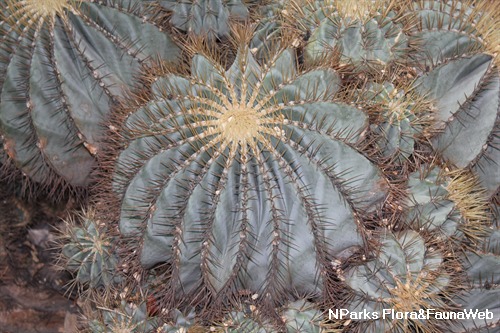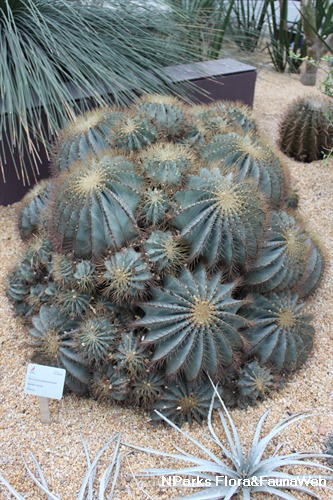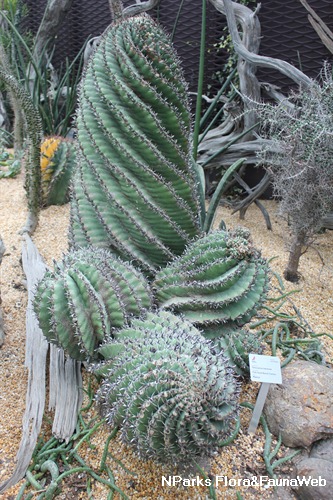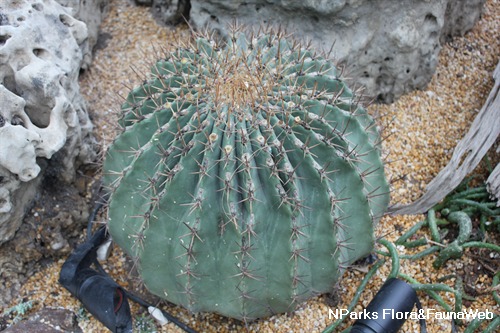
Back
Ferocactus glaucescens (DC.) Britton & Rose
| Family Name: | Cactaceae |
| Common Name: | Glaucous Barrel Cactus |
Name
Classifications and Characteristics
| Plant Division | Angiosperms (Flowering Seed Plants) (Dicotyledon) |
|---|---|
| Plant Growth Form | Shrub |
| Lifespan (in Singapore) | Perennial |
| Mode of Nutrition | Autotrophic |
| Plant Shape | Rounded, Columnar |
| Maximum Height | 45 cm to 70 cm |
| Maximum Plant Spread / Crown Width | 50 cm to 60 cm |
Biogeography
| Native Distribution | Mexico |
|---|---|
| Native Habitat | Terrestrial |
| Preferred Climate Zone | Desert / Arid |
| Local Conservation Status | Non-native (Horticultural / Cultivated Only) |
Description and Ethnobotany
| Growth Form | Either a solitary individual with a round to cylindrical shape or a large clump composed of many offshoots. |
|---|---|
| Stems | Bluish to greyish-green stem is round or cylindrical (45-70 cm tall, 50-60 cm wide). The stem is composed of ribs lined with areoles that produce golden yellow, stiff spines. Each areole produces 4-8 radial spines and sometimes 1 central spine. |
| Flowers | Yellow, funnel-shaped flowers are not showy (4 cm long, 2.5-3.5 cm wide). Plants typically begin to bloom at 12 years of age when they are about 15 cm wide or more. Flowers open only on sunny days and last for 3-4 days. |
| Habitat | Occurs on calcareous substrates, like coral reef and limestone, which produce soils rich in calcium and phosphorous. Found at altitudes up to 1,500 m. |
| Cultivation | This species is one of the easiest to grow in the genus Ferocactus. |
Plant Care and Propagation
| Light Preference | Full Sun |
|---|---|
| Water Preference | Little Water |
| Propagation Method | Seed |
Foliar
| Foliar Modification | Spine (axillary) |
|---|
Floral (Angiosperm)
| Flower & Plant Sexuality | Bisexual Flowers |
| Flower Colour(s) | Yellow / Golden |
|---|---|
| Flowering Period | Once Yearly |
| Flower Lifespan on Plant | Several Days (4) |
| Flowering Habit | Polycarpic |
Image Repository
Others
| Master ID | 31842 |
|---|---|
| Species ID | 6242 |
| Flora Disclaimer | The information in this website has been compiled from reliable sources, such as reference works on medicinal plants. It is not a substitute for medical advice or treatment and NParks does not purport to provide any medical advice. Readers should always consult his/her physician before using or consuming a plant for medicinal purposes. |





